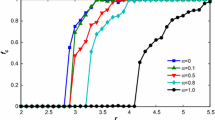Abstract
This paper studies the inverse Stackelberg game with multiple hierarchies under global and local information structures, where the players have discrete strategy spaces. For the classic public goods game, we solve the pure-strategy inverse Stackelberg equilibria under three typical hierarchical structures. The results reveal some counterintuitive characteristics within the systems with hierarchies, such as that the cooperation does not increase with the return rate at the equilibria. Furthermore, by defining a local information structure, we give an estimate of the fewest hierarchies required for full cooperation, which can be a constant multiple of the logarithm or square root of the population size or of the population size itself, according to different information structures and return rates. This paper proposes a novel mechanism to play the game and promote cooperation. Both the formulation and analysis method are different from existing works, and the results can find their ample implications in practice, which might help decision making in hierarchical systems.


Similar content being viewed by others
References
Hardin, G.: The tragedy of the commons. Science 62, 1243–1248 (1968)
Ostrom, E.: Governing the Commons. Cambridge University Press, New York (1990)
Ostrom, E.: Coping with tragedies of the commons. Annu. Rev. Pol. Sci. 2(1), 493–535 (1999)
Andreoni, J., Harbaugh, W., Vesterlund, L.: The carrot or the stick: rewards, punishments, and cooperation. Am. Econ. Rev. 93(3), 901 (2003)
Sefton, M., Shupp, R., Walker, J.M.: The effect of rewards and sanctions in provision of public good. Econ. Inq. 45(4), 671–690 (2007)
Choi, J.K., Ahn, T.K.: Strategic reward and altruistic punishment support cooperation in a public goods game experiment. J. Econ. Psychol. 35, 17–30 (2013)
Rand, D.G., Dreber, A., Ellingsen, T., Fudenberg, D., Nowak, M.A.: Positive interactions promote public cooperation. Science 325(5945), 1272–1275 (2009)
Santos, F.C., Santos, M.D., Pacheco, J.M.: Social diversity promotes the emergence of cooperation in public goods games. Nature 454(7201), 213–216 (2008)
Hauert, C., Holmes, M., Doebeli, M.: Evolutionary games and population dynamics: maintenance of cooperation in public goods games. Proc. R. Soc. Lond. B, Biol. Sci. 273(1600), 2565–2571 (2006)
Hauert, C., De Monte, S., Hofbauer, J., Sigmund, K.: Volunteering as red queen mechanism for cooperation in public goods games. Science 296(5570), 1129–1132 (2002)
List, J.A., Reiley, D.L.: The effects of seed money and refunds on charitable giving: Experimental evidence from a university capital campaign. J. Polit. Econ. 110(1), 215–233 (2002)
Isaac, R.M., Walker, J.M., Williams, A.W.: Group size and the voluntary provision of public goods: experimental evidence utilizing large groups. J. Public Econ. 54(1), 1–36 (1994)
Li, M., Song, H., Zhang, L., Zhang, L.: Maintenance of cooperation in a public goods game: a new decision-making criterion with incomplete information. Chin. Sci. Bull. 57(6), 579–583 (2012)
Nowak, M.A.: Five rules for the evolution of cooperation. Science 314(5805), 1560–1563 (2006)
Varian, H.R.: Sequential contributions to public goods. J. Public Econ. 53, 165–186 (1994)
Bag, P.K., Roy, S.: On sequential and simultaneous contributions under imcomplete information. Int. J. Game Theory 40, 119–145 (2011)
Gachter, S., Nosenzo, D., Renner, E., Sefton, M.: Sequential vs. simultaneous contributions to public goods: Experimental evidence. J. Public Econ. 94(7), 515–522 (2010)
Von Stackelberg, H.: Marktform und Gleichgewicht. Vienna (1934). Market Structure and Equilibrium. Springer, Berlin (2011) (In English). Translated by, Bazin, D. and Urch, L. and Hill, R.
Shen, H., Basar, T.: Incentive-based pricing for network games with complete and incomplete information. In: Jorgensen, S. (ed.) Advances in Dynamic Game Theory. Annals of the ISDG, vol. 9, pp. 431–458. Birkhauser, Boston (2007)
Basar, T., Olsder, G.J.: Dynamic Noncooperative Game Theory, 2nd edn. SIAM Series in Classics in Applied Mathematics. SIAM, Philadelphia (1999)
Ho, Y.C., Luh, P.B., Muralidharan, R.: Information structure, Stackleberg game, and incentive controllability. IEEE Trans. Autom. Control 26, 454–460 (1981)
Witsenhausen, H.S.: Separation of estimation and control for discrete time systems. Proc. IEEE 59(11), 1557–1566 (1971)
Olsder, G.J.: Phenomena in inverse Stackleberg games, Part I: Static problems. J. Optim. Theory Appl. 143, 589–600 (2009)
Olsder, G.J.: Phenomena in inverse Stackleberg games, Part II: Dynamic problems. J. Optim. Theory Appl. 143, 601–618 (2009)
Stankova, K.: On Stackelberg and inverse Stackleberg game and their applications in the optimal toll design problem, the energy markets liberalization problem, and in the theory of incentive. NGInfra serie, Delft University of Technology, the Netherlands (2009)
Basar, T., Selbz, H.: Closed-loop Stackelberg strategies with applications in the optimal control of multilevel systems. IEEE Trans. Autom. Control 24, 166–179 (1979)
Basar, T.: Equilibrium strategies in dynamic games with multi-levels of hierarchy. Automatica 17(5), 749–754 (1981)
Pang, J.S., Fukushima, M.: Quasi-variational inequalities, generalized Nash equilibria, and multi-leader-follower games. Comput. Manag. Sci. 2(1), 21–56 (2005)
Nie, P.Y., Chen, L.H., Fukushima, M.: Dynamic programming approach to discrete time dynamic feedback Stackelberg games with independent and dependent followers. Eur. J. Oper. Res. 169(1), 310–328 (2006)
Mu, Y., Guo, L.: Optimization and identification in a non-equilibrium dynamic game. In: Proceedings of the 48th IEEE Conference on Decision and Control, pp. 5750–5755 (2009)
Mu, Y., Guo, L.: How cooperation arises from rational players? In: Proceedings of the 49th IEEE Conference on Decision and Control, pp. 6149–6154 (2010)
Mu, Y., Guo, L.: Towards a theory of game-based non-equilibrium control systems. J. Syst. Sci. Complex. 25, 209–226 (2012)
Acknowledgements
The author thanks Professor Lei Guo in AMSS, CAS, for his inspiring help through the paper.
Author information
Authors and Affiliations
Corresponding author
Additional information
Communicated by Qianchuan Zhao.
Rights and permissions
About this article
Cite this article
Mu, Y. Inverse Stackelberg Public Goods Game with Multiple Hierarchies Under Global and Local Information Structures. J Optim Theory Appl 163, 332–350 (2014). https://doi.org/10.1007/s10957-013-0475-5
Received:
Accepted:
Published:
Issue Date:
DOI: https://doi.org/10.1007/s10957-013-0475-5




